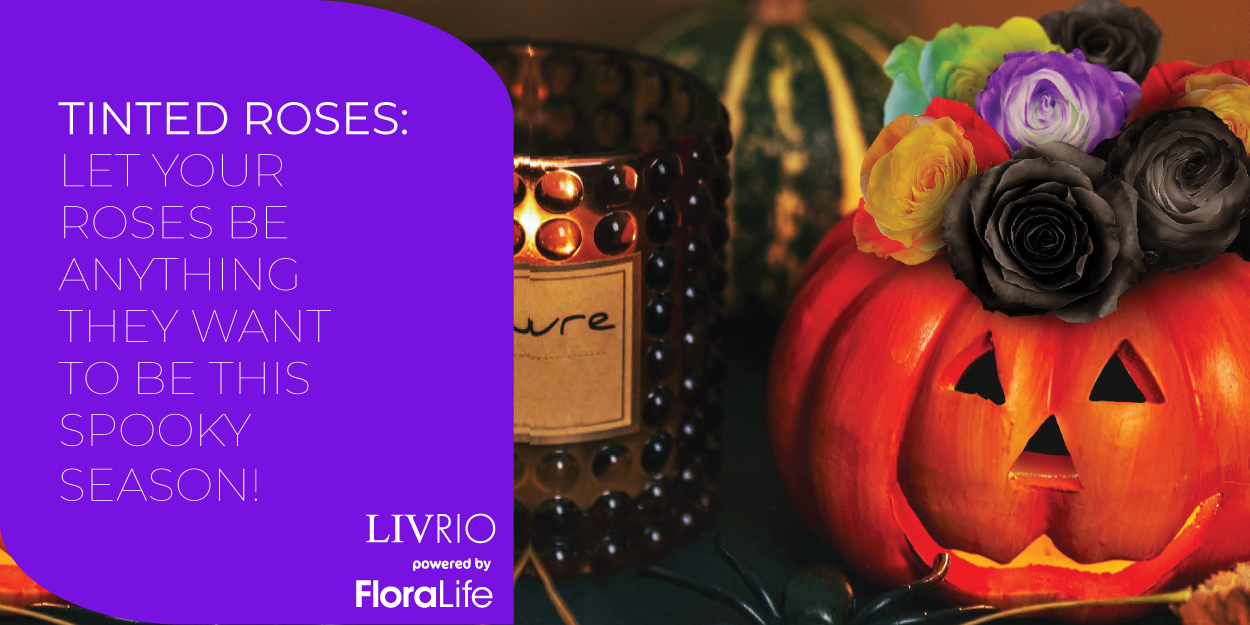Tinted Roses
LivRio Magazine October 2023, powered by FloraLife

Let your roses be anything they want to be this spooky season!
October is a magical time, as it not only kicks off the beginning of ‘sweater weather’, and all things ‘pumpkin spice’ but it also signals the start of Halloween, AKA the spooky season! This is the time of year when creativity gets unleashed, and anything can be transformed including roses.
But how, I hear you say? Well by creating flower colors and combinations not seen in nature. This is done by tinting the flowers which can be achieved using three different methods:
- The uptake method, in which flowers are placed in a hydration solution which includes a colored dye. The flowers then uptake the dye through the xylem until it reaches the petals. Tinting flowers using this method often show signs of the color used throughout the stem and leaves, as well as the flowers.
- The dip method, in which only the flower heads are dipped into a colored dye solution. Here, only the petals are colored and the leaves are left untouched.
- The spray method, in which the flowers are sprayed with a water-based color spray.
Working with and handling dyed flowers is similar to natural flowers, but there are some things you should know and expect before you receive them. Some helpful hints for working with dyed flowers include:
- Dye from the flowers will color the water they are in, this is perfectly normal, don’t worry. You do not need to change the water or re-process the flowers.
- When placing dyed flowers in a clear vase or container you will be able to see the tinted water, which can be a fun feature, but if you want to disguise this, simply choose an opaque container.
- Because of the dying process, the foliage of dyed flowers can be slightly compromised versus flowers that are 100% natural. You may prefer to remove some of the foliage.
- If your design includes dyed and natural flowers, the natural flowers may take on some of the tint once processed and placed in the same water/solution as the dyed flowers. This can actually enhance the look of your overall design as the tint would be subtle.
- Be aware the dye can seep through the leaves. Always handle dyed flowers with care when processing or putting them on display and avoid contact with clothing or tablecloths as dye could transfer. Advise customers when they are purchasing so they can be sure to avoid transferring the dye also.
Dyed flowers, as with any other cut flower, require proper care and handling. For best results we recommend these care and handling best practices:
- Start with a clean bucket, sanitized with a floral cleaner such as FloraLife® D.C.D.® Cleaner.
- Fill buckets with cool water mixed with flower food solution according to manufacturer’s recommendation. Do not put flowers directly into metal/galvanized buckets. Use clean, good quality water and do not use water that has been treated with a water softener as the salt levels can be damaging to flowers. Use a dosing unit that is properly calibrated, or hand mix the solution according to label instructions.
- Remove any foliage that would fall below the solution level.
- Re-cut stems approximately 1” using clean and sanitized clippers or knife. Use FloraLife® Quick Dip to jump-start hydration and ensure free-flowing stems.
- Immediately place flowers in previously prepared container.
- Allow minimum 2 hours to hydrate placing buckets in an area with good airflow.
- Always remember FIFO (first in first out) when rotating flowers.
Regardless of how they have been colored, tinted flowers require the same care and attention as any other flower, so make sure you treat them right.
*Product availability depends upon geographical region.
Check https://floralife.com/products/#product_grid for more information.
